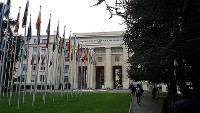Convention on Long-range Transboundary Air Pollution (LRTAP)
In the 1990s, IIASA pioneered a cost-effectiveness approach for determining the international distribution of emission reductions, which was adopted as a guiding rationale by the negotiations for the Second Sulfur Protocol in 1994. The Gothenburg protocol of 1999 and its 2012 revision employed the multi-polllutant/multi-effect concept developed by IIASA in its GAINS model.
IIASA, as the designated 'Centre for Integrated Assessment Modelling' the Convention, prepares policy reports to the negotiations on a regular basis. Read more ...
The 2012 Revision of the Gothenburg Protocol
The GAINS model was used to explore cost-effective emission ceilings for the negotiations on the revision of the Gothenburg Protocol in 2012. More
The 1999 Gothenburg Protocol to Abate Acidification, Eutrophication and Ground-level Ozone
With the multi-pollutant/multi-effect concept of its RAINS model, IIASA provided structure to the negotiations on emission ceilings for SO2, NOx, VOC and NH3 that lead to significant improvements for acidification, eutrophication and ground-level ozone. More




